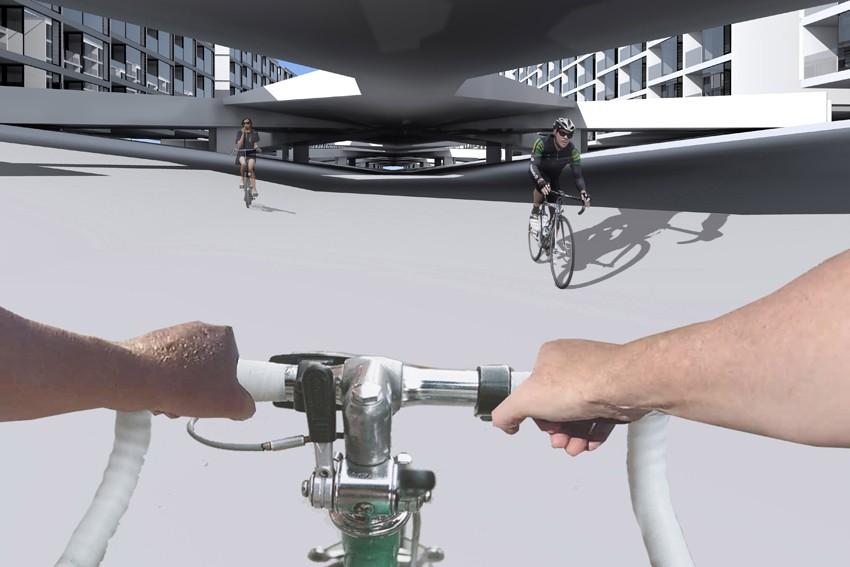Cycling for Space

Playing host to a European conference on bicycle transport seems as likely a role for an Australian city as hosting a Winter Olympics.
The European leaders coming to Adelaide’s Velo-City in May are accustomed to seeing people of every age riding slowly on the safe side of parked cars, not “vehicular cyclists” competing with moving cars in the carriageway. Europeans are also used to cyclists in heels with their hair flowing, not cyclists in day-glow showing more of their rear-ends than they show of their heads. Sure, there are sportive cyclists in Europe as well. However, these aren’t the ones who make up the numbers—who give cities like Amsterdam and Copenhagen more bicycle travellers than drivers or users of public transport. Depending on where you sit on the progressive/conservative scale, you will either be beaming to have heard that Australia is lagging, or wishing I would give you another side of the story. For the latter among you, here are some pearls. At any given moment hundreds of kilometres of safe cycle tracks in cities like Barcelona, Paris and Amsterdam, are neutralised by cars, buses or lorries illegally parked there. And how safe are cycle tracks anyway, with motor scooters doing sixty along them? There are punch-ups over bike racks at train stations each morning. Meanwhile, billions have been spent on indoor car parking but only pennies on similarly secure space to park bikes. That means two things: One, that many Europeans aren’t riding because their bikes have been stolen, and; two, that those who do ride are riding on clunkers so squeaky they would rather just ride to a station than their destination. While I’m picking on faults, I’ll add that I find it perverse how many cyclists in Europe wear inconveniences like these as badges of honour. Herein lies the universal dilemma that holds bike transport back. Cyclists want to be David, and have drivers play the part of Goliath. They want to be underdogs yet take the moral high ground. Thus if you want to outrage a room full of bicycling advocates, don’t draw attention to gross inequities like the car and bike transport budgets. In Australia, tell them you want them to have their own infrastructure to protect them from cars. In Europe, just tell them that their bike tracks could have canopies to protect them from rain. Tell cyclists that bicycle transport should be so cosy that even the most lily-livered car-driving fop makes the switch and starts riding, then watch them erupt! That’s not a pity for those cycling now, given current conditions. It’s a pity for those who want conditions to change before they start riding. That could be the whole population. The Effective Speed of bike transport in a city cleared of cars and their traffic lights is 16kph. A simple formula can be used to determine the Effective Speed (ES) of car travel: time driving (T) plus time worked paying to drive (P), divided by distance (D). That is: ES=(T+P)÷D. Paul Tranter has shown it’s less than 10kph in most cities. So the question is this: why has this slow and menacing machine, called a car, been allowed to impinge upon cycling, when the latter would make all our lives more speedy and safe? One answer is that the car provides a covered route for its occupants, wherever they point it. So in effect we are paying all the hidden costs of car travel — greenhouse emissions, road deaths, sedentary diseases, pollution, traffic jams, etc. — because we’re too cheap to build shelter for cycling as a public resource. One way to escape the mad cycle of building new cities with parking and roads, which guarantee they’ll be car-centred forever, would be to build a pioneer town with no car access at all. It would have covered bikeways instead, plus apartment buildings and shops that are designed for riding inside. Design investigations I have led with my students at The University of Tasmania suggest a better quality of life could be had in a bike-focussed city than a city for cars. For example, a mother could ride with her baby asleep in a cargo bike, all the way from the nappy aisle to the cot room, and not even risk getting wet. In my last book, Cycle Space, I argued that the obvious places to build for the bike in this way are former industrial redevelopment sites. Most are intersected by former rail routes and once working waterfronts, which are already being made into bike routes. What developers would save by not building parking, they could spend upgrading and lengthening bike routes — giving them roofs! The book I am working on now develops a toolbox of building types and land-sculpting techniques to make cities as natural for cycling as suburbia is natural for driving a car. In the past year, I’ve presented designs for bike cities in Singapore, Rotterdam, New York, Sydney, Canberra and Amsterdam. How well these designs are received depends, in each case, on how many in my audience would rather be Davids, and how many want this mode to be giant. Steven Fleming will be speaking at Velo-City Global 2014, Adelaide Convention Centre, Tuesday, May 27 to Friday, May 30 velo-city2014.com